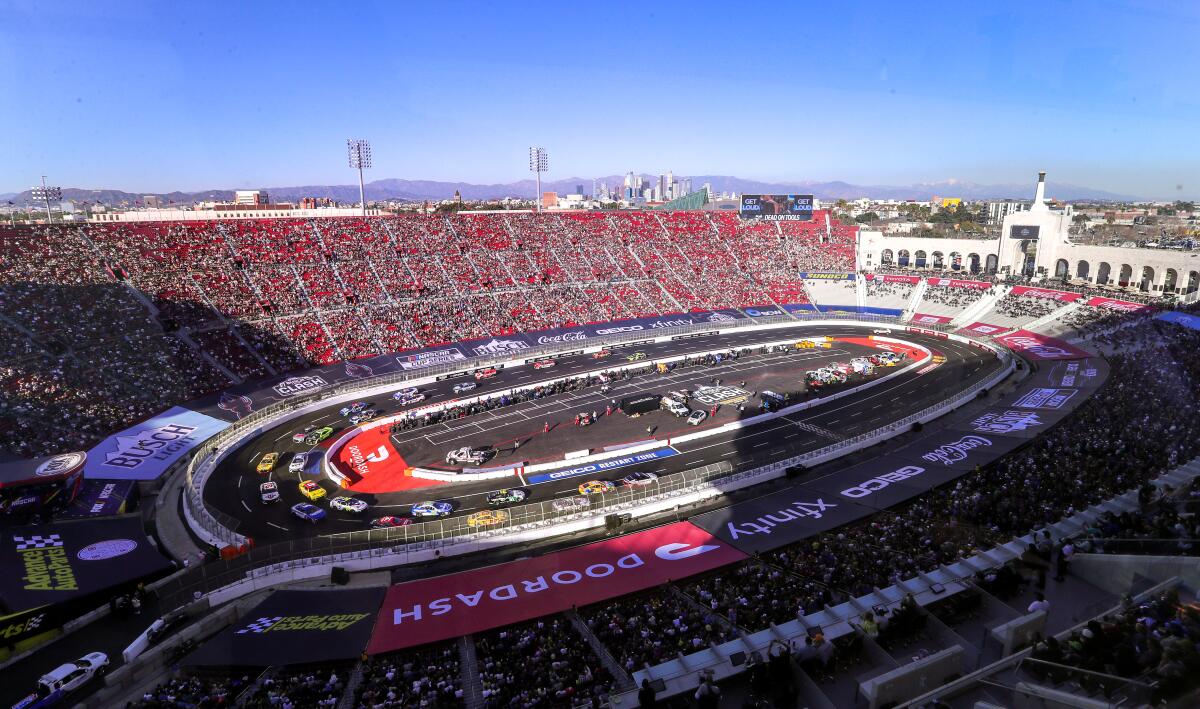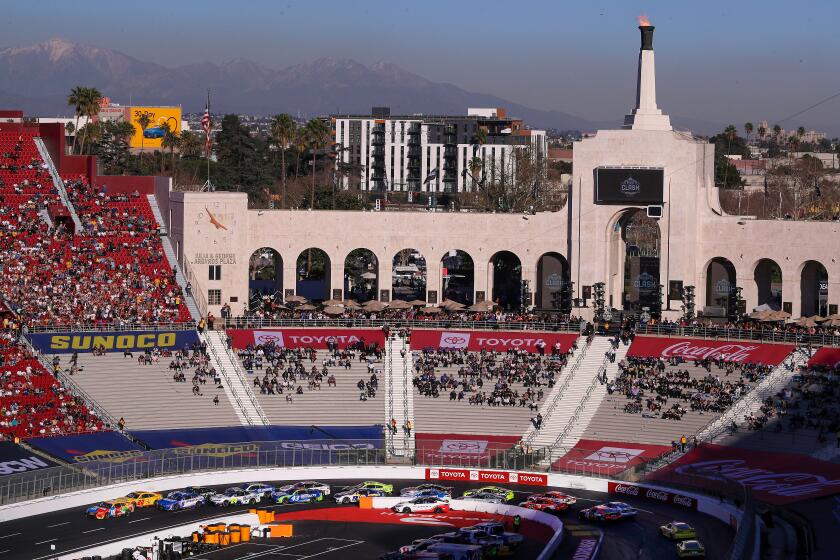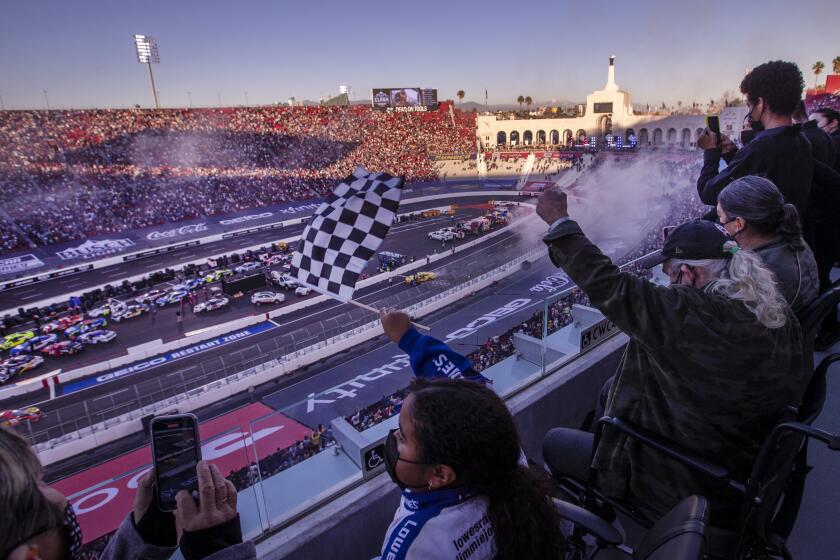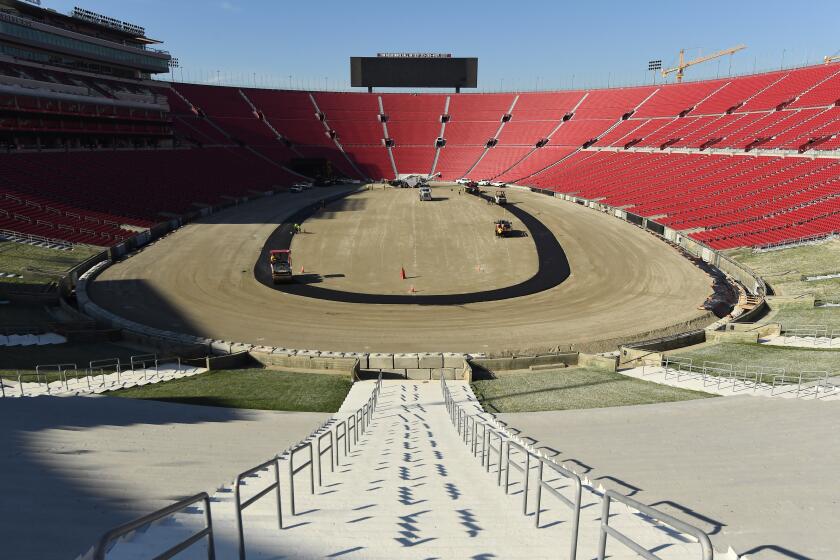Clash at the Coliseum a blueprint for NASCAR’s plan to expand into untapped markets

- Share via
A tight track squeezed into a historic football stadium populated by the debut of racecars with a new design posed a risk as well as an opportunity for NASCAR on Sunday.
The opportunity was what one NASCAR official described as a “proof of concept,” a chance to broaden the sport’s audience and provide a template for future forays into other large markets unfamiliar with the in-person spectacle of race day.
The risk, of course, was taken primarily by the drivers, navigating a cramped quarter-mile track they’d never traversed that required constant braking and turning because straightaways were nearly nonexistent. And doing so in brand-new cars dubbed Next Gen.
The only asphalt track drivers could compare this to is Martinsville (Va.) Speedway, which while notoriously tight is a tad longer than a half -mile. While the quarter-mile track slowed speeds — the average of 63 mph was no doubt exceeded by most of the approximately 55,000 fans taking freeways home — it increased braking and bumping and produced crowd-pleasing drama.
Photos from the NASCAR Clash at the Coliseum exhibition race held in the historic Los Angeles Memorial Coliseum.
The race went off without a major hiccup, ending with Joey Logano winning by three car lengths and doing smoky celebratory burnouts even before all the other cars had crossed the finish line. His wife, Brittany, is due to deliver their third child any day.
“I told her, if you’re having the baby, I’m running right off the track from here,” Logano said. “But I think we’re safe for tonight. This is special to get the first Next Gen win, the first win here in the Coliseum.”
Ben Kennedy, NASCAR’s senior vice president of strategy and innovation, was more subdued than Logano but just as pleased. He and NASCAR executive vice president Steve O’Donnell exchanged high-fives outside the interview room with drivers Kyle Busch and Austin Dillon, who finished second and third, respectively.
The 150-lap Busch Light Clash at the Coliseum exhibition was Kennedy’s brainchild. Not only was it considered a resounding success, it can serve as a blueprint. Kennedy and O’Donnell acknowledged that converting the Auto Club Speedway in Fontana from a two-mile track to a half-mile is under consideration. The venue has hosted NASCAR races since 1997 and this year’s race is right around the corner Feb. 27, one week after the Daytona 500.
NASCAR provides plenty of bumper grinding and wrecks in the tight confines of the Coliseum, much to the delight of fans and drivers who take it all in.
Shorter tracks in large stadiums never before considered by NASCAR are suddenly not only on the table, but an appealing main course. About 70% of the crowd Sunday had never purchased a NASCAR ticket, according to Ticketmaster. Drivers commented on how loud the crowd sounded in the stadium’s bowl configuration.
The uniqueness of the venue and specter of replicating the experience elsewhere relegated discussion of the Next Gen cars to the backseat. O’Donnell marveled that the television broadcasters barely mentioned the cars, even though questions loomed regarding their safety and efficiency.
Next Gen cars were nearly delayed until 2023 because a dummy allegedly was “killed” in crash testing last summer. The cars include fundamental upgrades such as independent rear suspension, a sequential-shift transmission, aluminum wheels and composite bodies. Their dimensions are more like regular cars. However, critics said they pose a risk because they lack enough sufficient body areas that will crumple during a collision.
Several drivers experienced mechanical issues. Kennedy and O’Donnell said every car that exited the race will be thoroughly examined. Busch countered by saying the new cars enabled drivers to go farther before burning out their tires on a track that required constant braking and turning punctuated by brief bursts of acceleration.
The daylong Clash at the Coliseum began with five heats and a dramatic last-chance qualifier that included serious jostling and several spinouts. Pit stops weren’t allowed but Pitbull put on a concert after the qualifier and Ice Cube did the same during a halftime after 75 laps of the main race.
Although this was a first for NASCAR, the Coliseum has staged events that required extensive retooling of the field surface. The most recent was Stadium Super Trucks in 2013 and perhaps the first was the Super Bowl of Motocross in 1972.
NASCAR spent more than $1 million building the track, and disassembled it mere hours after the race. Officials say the turf field will be restored in time for the L.A. Giltinis to play their professional rugby opener Feb. 27.
NASCAR teams have done what once seemed impossible, building a track inside L.A.’s Coliseum. This is how they did it and how drivers feel about it.
Deemed an unquestioned success, the Clash at the Coliseum instantly expanded NASCAR’s options. NASCAR has had exploratory discussions to construct a track at a venue in New York City or New Jersey. The Pacific Northwest is an untapped area. Dillon mentioned AT&T Stadium in Dallas as a dream venue. And let’s not forget the international market.
“We certainly think we can take bold steps with our schedule to broaden the fan base,” NASCAR official Matt Humphrey said. “In addition to cities in the U.S., we’d consider exploring Europe, Mexico, Asia, Australia. ... The world is our oyster.”
More to Read
Go beyond the scoreboard
Get the latest on L.A.'s teams in the daily Sports Report newsletter.
You may occasionally receive promotional content from the Los Angeles Times.














